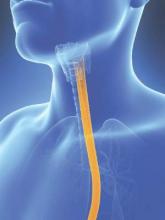SAN DIEGO – Hospitalists should evaluate their patients for aspiration syndrome and swallowing difficulty, known as dysphagia, more carefully than they now do, says a hospitalist at the Atlanta VA Medical Center.
Dr. Anna Von, a staff physician in the hospital medicine section at the Atlanta VA, spoke about the challenges of managing inpatient dysphagia at the annual meeting of the Society of Hospital Medicine. Her talk was entitled “Hard to Swallow: Dysphagia, Aspiration Syndromes, and Tube-Feeding Decisions for Inpatient Providers.”
Dysphagia affects as many as one in four inpatients overall and nearly half of frail seniors, she said. In addition, 75% of elderly patients with pneumonia have dysphagia.
Some patients may be appropriate for feeding tubes to prevent aspiration, depending on their condition, Dr. Von explained, but most of the time, feeding tubes may do more harm than good. Much of the time, modified diets and adjustments in the way patients eat or are fed may provide nutrition more safely than feeding tubes.
In a follow-up phone interview, Dr. Von elaborated on her presentation.
“In many advanced disease states, the burden of a feeding tube far outweighs any benefit,” she said. “It’s important to get a speech pathology evaluation to determine if the patient has a swallowing or aspiration issue, determine the extent, and suggest appropriate treatment.”
Dr. Von also said that calling for a speech pathologist to evaluate a patient one time may not be enough. “A lot of the time our physicians look for the speech pathologist to either pass or fail their patient, and if they pass, they say ‘good to go. I don’t need to worry about this anymore,’ and if they fail, they consider alternate means of nutrition, such as a feeding tube.”
“But it’s really more than just a pass-fail question,” she said. “There’s going to be degrees of severity in dysphagia; some people may benefit from a modified diet of a different consistency, and many benefit from different techniques they can use while swallowing that will increase efficiency of the swallow.”
For example, sometimes having a patient turn his or her head slightly when trying to swallow, especially if one side is impaired by stroke, may help them use muscles that are stronger on the other side, Dr. Von said.
Patients with dysphagia, however, “will always be at risk of having an aspiration complication,” she said. “And that should be well communicated.”
Providing nutrition arises frequently with families whose loved ones have forgotten how to swallow, or have lost muscle and nerve coordination due to their age or disease. They may think tube feeding will provide essential nutrition, prolong survival and help heal and prevent pressure ulcers. But they usually don’t, Dr. Von said.
“That’s exactly what we deal with on a day-to-day basis, the underlying emotional conflict: our instincts as humans and as caregivers to feed,” she explained. “But sometimes tube feeding offers more burden than benefit, and that’s hard to let go.” This is often a tough reality for families to comprehend, especially with advanced stages of disease, and hospitalists should consider having palliative care discussions rather than placing feeding tubes at the appropriate time.
Careful, monitored hand-feeding may at times be appropriate. There is an aspiration risk, Dr. Von said, but if the patient is given sufficient time to swallow each bite, and caregivers pay close attention to cues from the patient that they would like to eat, or that they’re not interested, hand feeding is usually a better alternative.
Changing Practice
Several studies, particularly one Dr. Von called “groundbreaking” in the Archives of Internal Medicine in 2012, found that for pressure ulcers, “feeding tubes offer no benefit and in fact may be associated with increased risk for pressure ulcers in patients with advanced dementia.”
Feeding tubes may require restraints and discourage mobility that helps wounds heal, but many practicing physicians do not understand that, she said. Numerous other studies found that feeding tubes do not improve survival or prevent aspiration pneumonia.
Nevertheless, feeding tube placement for patients with advanced dementia continues to be a common occurrence nationally, despite recommendations to the contrary, according to a February report from the Dartmouth Atlas. Using Medicare claims data, the report found that nationally in 2012, 6% of patients with advanced dementia had a feeding tube placed during their last six months of life, with regional rates varying widely.
Dr. Von speculated that feeding tube placement orders are often placed “as a default” for the interventional radiologist or gastroenterologist. “Once the order is written, the feeding tube gets placed, like a medication that’s just given rather than having a discussion about it,” she said. However, feeding tubes are often appropriate for patients with head and neck cancers, even if they’re advanced, she said. “That’s a different special case.”


